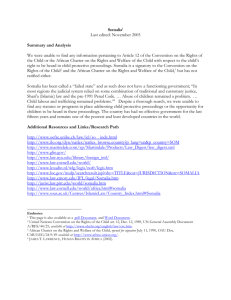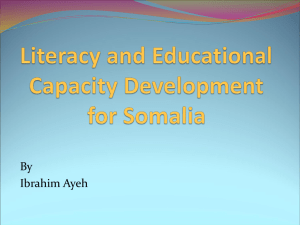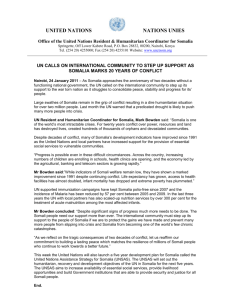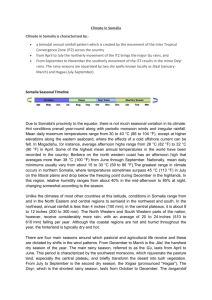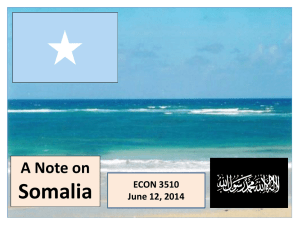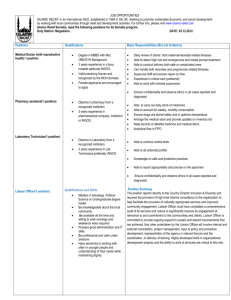File
advertisement
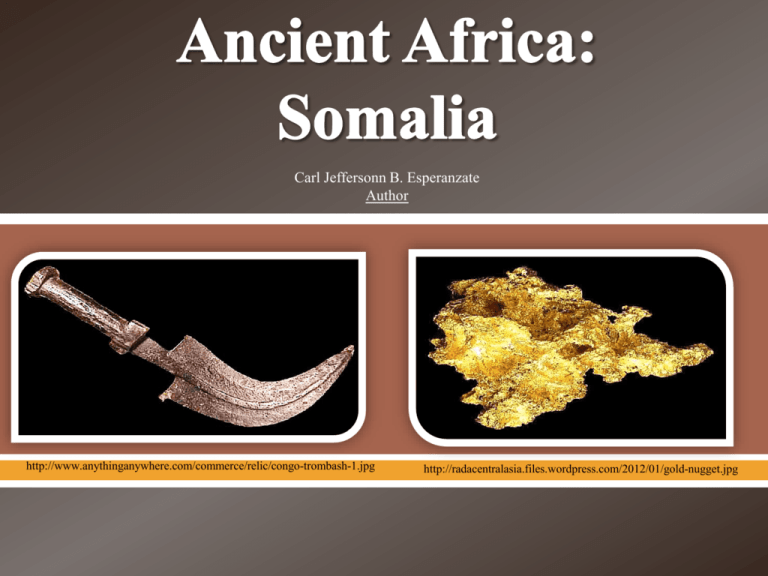
Carl Jeffersonn B. Esperanzate Author http://www.anythinganywhere.com/commerce/relic/congo-trombash-1.jpg http://radacentralasia.files.wordpress.com/2012/01/gold-nugget.jpg Ancient Africa : Somalia Ancient Somalia or Punt’s location is still the same where Somalia stands today. Punt or Somalia is north of the equator and is at the east side of the continent of Africa. Its neighboring countries are Arabia, Egypt, Persia, and India. Somalia is also on the silk road trade route. The temperature is hot and it is always very dry and not a lot of trees grow there. Luckily it’s right beside the Indian Ocean so you can have a fun time swimming! Did you know that Somalia was on the silk road? It became a very important trade city, just like Meroe. en.wikipedia.org/wiki/File:Silk-route.jpg Somalia is a civilization that uses kinship to bond together. They were also monotheistic and spoke Somali language. They had to work together to not get taken over by other civilizations. They told stories orally and by singing. They had droughts, famines, and diseases which made their life very harsh and difficult. So, if you want to have a really good dependable colony, come to ancient Somalia! We’ve got games and fun! http:www.nemo.nu/ibisportal/0egyptintro/1egypt/gudasidor/gudabuilder/nunboat.jpg Somalia’s politics are actually run by kings and queens. Then after the Persian Emperor Cambyses II conquered Ancient Egypt he told his ambassadors to bring gifts to the Macrobians in Somalia. But, instead the Macrobian king responded with a challenge to the Persians in the form of a unstrung bow and that they would have the right to invade Somalia if they manage to string it. Luckily Cambyses II never managed to string it leaving the Somali people in peace. Did you know? • Since they were by the Nile River, pirates attacked them once in a while. http://www.s9.com/images/portraits/4740_Cambyses-II.jpg One of the inventions that Somalia had done was a system of writing that has 21 consonants and 5 vowels called Somali. The Macrobians also mastered to live for a very long time averaging about 120 years. Archeologists described the Macrobians as the, “Tallest and handsomest of all men”. Talk about a change! Wouldn’t you want to live that long? So, start packing your bags and come to Ancient Somalia! They probably can tell you the secret… en.wikipedia.org/wiki/File:Ciismaniya.jpg Somalia’s culture was based on men doing all of the hard work and women staying at home taking care of the children. But, sometimes the women actually becomes the clan leader. The men wore very white clothes or turbans as well as the women did. Somalis are mostly meat eaters and vegetarians rarely occur. They ate goat, beef, lamb, and sometimes chicken with curry and rice. They told poems on a daily basis and most of it was about their jobs as a mat weaver. Mmm! That made me hungry! Come with me and we’ll eat tons of food and have a good time! You could maybe buy some of their cool clothes at their shops. www.somaliculture.net/dress/index.html Somalia’s economy was based on trading things at the market or the trade routes. They traded based on the barter system. Later on they used coins to buy the resources that they need. They used the ocean and the roads to trade. They traded incense, ebony, short-horned cattle, gold, ivory, and animal skins. Did you know? • They used the barter method for many years. • Punt was a major trade city because of their resources like gold, salt, iron, and jewelry. http://housemedicalclinic.com/image/barter%2520300.jpg Hamilton, Dr. Charles., et al. Ancient Civilizations. Orlando: Harcourt Horizons, 2003. Students of Abraham Moss High School. “Somali Culture Home Page”. The Food of Somalia. Abraham Moss High School. Abraham Moss High School. December 5, 2012. http://www.somaliculture.net/index.html. Wikipedia. “History of Somalia”. Wikipedia, the free encyclopedia. November 16, 2012. Wikipedia Foundation Inc. December 5, 2012. http://en.wikipedia.org/wiki/History_of_Somalia. Wikipedia. “History of Somaliland”. Wikipedia, the free encyclopedia. December 5, 2012. Wikipedia Foundation Inc. December 10, 2012. http://en.wikipedia.org/wiki/History_of_Somaliland.
